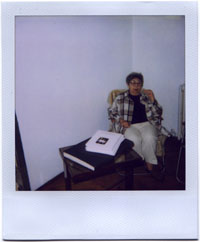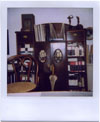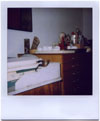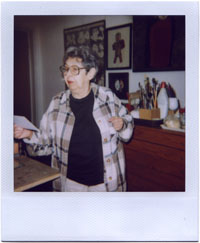Geta Bratescu
Interview with Geta Bratescu
Geta Bratescu, I'll permit myself to call her the "Romanian Art Diva,"
is 75 years old. Born in 1926, at the beginning of the 70ies she mixes painting
and photography, works objects, installations, book-objects, video and performance,
her first movies are on 35 mm film.
In 1960 she represents Romania at the Venice Biennial, and in 1983 and 1987
participates in the Biennial of Sao Paolo.
- When and how did you get involved in contemporary art?
 In
the 70ies I started to use non-traditional techniques, to search for new ways
of expression. This is my catalog, we published it in 1999 and it covers all
of what I have tried and succeeded in making during all those years of active
creative work. It also includes some critical texts in Romanian and English.
You'll find further information there.
In
the 70ies I started to use non-traditional techniques, to search for new ways
of expression. This is my catalog, we published it in 1999 and it covers all
of what I have tried and succeeded in making during all those years of active
creative work. It also includes some critical texts in Romanian and English.
You'll find further information there.
This side of art is exclusive. During all this time I was drawing a lot, I
really love drawing. There was a period in which I was involved mainly in textile
and lithography. These were techniques which allowed me to do things that were
visually new, to experiment, because the system did not allow much. For instance,
through textile I tried to use various materials or to materialize some ideas,
which was impossible with the means of painting. I can say that it is only in
the 90ies that I really had the possibility to get involved in contemporary
art and video, to express myself freely.
 After
I graduated from the Academy of Art, which is traditional and has rubber-stamped
tradition, if we look in the National Art Museum what was being done in those
times, we can see that the most common themes are the nature morte and the landscape
of the time.
After
I graduated from the Academy of Art, which is traditional and has rubber-stamped
tradition, if we look in the National Art Museum what was being done in those
times, we can see that the most common themes are the nature morte and the landscape
of the time.
I didn't have much information what is being done in the West, how the artistic
currents of the 60ies and 70ies were developing there.
My professor at the Academy kept repeating to me: "You are a better drawer
than you are a painter." After four years they excluded me from the Academy
for political reasons, this was in 1945, and after that in 1967 I entered the
Academy again for two years. I needed a diploma. At the time it was a great
disadvantage not to have a diploma. In the 50ies my luck was drawing, as a means
to survive. I was drawing various individuals, this was the beginning, and illustrations
for children's books. Illustrations are a way to survive with something nice,
which was not that much of a compromise.
But the whole story started later, when my fate as an artist became confirmed,
when I bought a studio and acquired this idea of the Studio. The Studio as a
space of your own, a moral-mystic space. In my Studio I developed myself, step
by step, and could be myself. The Studio, that's more of an idea, an idea about
a private space that you're always carrying along with you, not only a real
physical space that you can buy. To be able to build up, to create, to own such
a space is really great, a Studio of one's own.
- Did you have some idea of the feminist movement and other political struggles
that find their expression in the work of many artists, writers, directors during
the 60ies in the West? Were you interested in what was going on across the "Iron
Curtain", what was happening there with culture, how visual arts were developing?
Yes, I had heard! But I was a rather isolated artist. I didn't have another
choice then. I was forced to develop my own individualism. We did not have the
possibility of group gestures or activities. If I am a feminist, it is through
obstinacy. This means that I wink at whatever happens.
- Did you feel some sort of pressure from the art circles and institutions,
being a woman artist?
 My
great luck was that my husband is an engineer, and my son is a mathematician,
so that within the family I'm not faced with competition. But I was fortunate
enough that they like what I do, and they have always supported me greatly in
my work. I was lucky that other people liked what I do, too. This helps the
artist. As a whole, good design is seen as man's work, but I had the opportunity
to be involved also in that, all of twenty years, doing the graphic design of
one of the most interesting magazines for culture, philosophy, sociology, critique
and literature here in Romania "Secolul 20" (20th Century).
I was quite flattered when in 1997 they called me back to work for the magazine,
after I had retired in 1983. In my work as a designer I always strove to visualize
the ideas in the text, to give them a new, non-standard reading, and not to
illustrate or to decorate. I was looking at the book as an object and tried
with all sorts of visual means to broaden the horizon of the reader, to educate
her or him visually. I find that the opportunity to work in graphic design was
important for my development as an artist. I think that design work helps the
artist to develop also other skills that can be useful to her or him. My work
as a designer gave me freedom and knowledge, which I could use in my other projects
as well.
My
great luck was that my husband is an engineer, and my son is a mathematician,
so that within the family I'm not faced with competition. But I was fortunate
enough that they like what I do, and they have always supported me greatly in
my work. I was lucky that other people liked what I do, too. This helps the
artist. As a whole, good design is seen as man's work, but I had the opportunity
to be involved also in that, all of twenty years, doing the graphic design of
one of the most interesting magazines for culture, philosophy, sociology, critique
and literature here in Romania "Secolul 20" (20th Century).
I was quite flattered when in 1997 they called me back to work for the magazine,
after I had retired in 1983. In my work as a designer I always strove to visualize
the ideas in the text, to give them a new, non-standard reading, and not to
illustrate or to decorate. I was looking at the book as an object and tried
with all sorts of visual means to broaden the horizon of the reader, to educate
her or him visually. I find that the opportunity to work in graphic design was
important for my development as an artist. I think that design work helps the
artist to develop also other skills that can be useful to her or him. My work
as a designer gave me freedom and knowledge, which I could use in my other projects
as well.
 There
were many women artists, working mostly in textile, engraving, stage design,
but there were also many women artists working mainly in painting, not so much
sculpture - after all, that can be quite heavy physical work. So that women
artists have given something to Romania during that period, but we have never
organized in women's organizations, there was no ideology pointing in that direction,
so that we never gathered, we did not rise up and did not discuss questions
related to women's rights. In the institutions and the key posts in the sphere
of culture there were mainly men, but I am myself not a good example in this
direction, perhaps I don't have much of a right to take a position, since I
never had any ambition to break through and make a career in this direction,
to deal with institutions, where there are mostly men. Actually, I do have a
bit of experience in this direction. In 1957 I organized an exhibition on the
human body at the Medical Academy in Bucharest, together with Silvia Rado, who
is a sculptor. The undertaking of organizing this exhibition was quite courageous
for the time and created a few problems. Because the naked body was not accepted,
it was not ideologically correct. It was an exhibition with nude drawings by
several artists, sculptors and painters. We selected for each drawing a quotation
from texts of Paul Valéry and other interesting authors on the topic
and added them to the drawing, hung on the wall.
There
were many women artists, working mostly in textile, engraving, stage design,
but there were also many women artists working mainly in painting, not so much
sculpture - after all, that can be quite heavy physical work. So that women
artists have given something to Romania during that period, but we have never
organized in women's organizations, there was no ideology pointing in that direction,
so that we never gathered, we did not rise up and did not discuss questions
related to women's rights. In the institutions and the key posts in the sphere
of culture there were mainly men, but I am myself not a good example in this
direction, perhaps I don't have much of a right to take a position, since I
never had any ambition to break through and make a career in this direction,
to deal with institutions, where there are mostly men. Actually, I do have a
bit of experience in this direction. In 1957 I organized an exhibition on the
human body at the Medical Academy in Bucharest, together with Silvia Rado, who
is a sculptor. The undertaking of organizing this exhibition was quite courageous
for the time and created a few problems. Because the naked body was not accepted,
it was not ideologically correct. It was an exhibition with nude drawings by
several artists, sculptors and painters. We selected for each drawing a quotation
from texts of Paul Valéry and other interesting authors on the topic
and added them to the drawing, hung on the wall.
- But now, when I look through your catalog, I'm really impressed and surprised!
Your works from the 70ies are quite in the spirit of the feminist tradition,
fully adequate in the context of the time and compared with what was being done
in the West as experimental practices and contemporary art. In the Bulgarian
fine arts of that time there is not a single such case of an artist who would
have been adequate on an international level!
Ah, you mean this work? "The Smile" is inspired by "Burda",
you remember that magazine for housewives…?
Everything that I do or have done, I see as women's art. I would not want to
do men's art, this would be impossible…
Dimitrina Sevova - In Someone Else's Skin (2001)
Index of the Interviews
 In
the 70ies I started to use non-traditional techniques, to search for new ways
of expression. This is my catalog, we published it in 1999 and it covers all
of what I have tried and succeeded in making during all those years of active
creative work. It also includes some critical texts in Romanian and English.
You'll find further information there.
In
the 70ies I started to use non-traditional techniques, to search for new ways
of expression. This is my catalog, we published it in 1999 and it covers all
of what I have tried and succeeded in making during all those years of active
creative work. It also includes some critical texts in Romanian and English.
You'll find further information there. 

